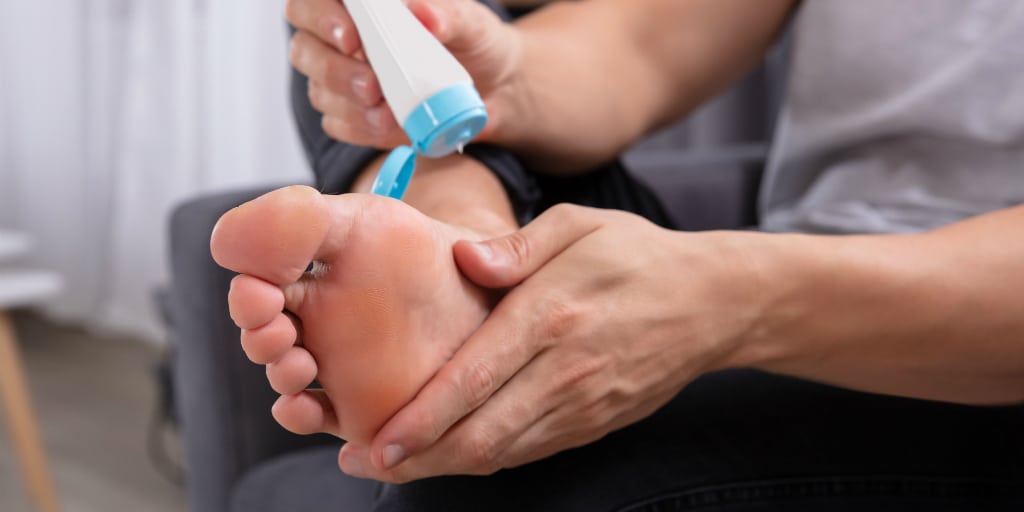It’s wintertime again in West Michigan. And with the excitement of the holiday season rapidly coming to an end, we know what we’re in for—a few more months of frigid temperatures and deep, wet snow.
Now, some of us love to play all day in the snow when we get the chance. (Our own Dr. Bredeweg has even been known to hit the ski slopes from time to time.) Others would rather shut themselves inside with a good book and cup of cocoa, read for a while, and then try to sleep straight through to spring.
But regardless of your attitude toward Michigan winters, the season can be rough on your feet and toenails. Indoors and out, your skin and nails face challenges they might not have to deal with during warmer, sunnier months.
And these challenges can increase your risk of developing or contracting a wide variety of frustrating skin and nail conditions.
Below, read up on a few of the most common of these conditions, why the winter season may increase your risk, and what you can do about them.
Athlete’s Foot and Fungal Toenails
You might not know this, but these two conditions have a lot in common.
Number one, they’re both caused by the same kinds of fungi, and that fungi loves to hang out in warm, humid, and dark conditions. Like, for example, the inside of a soggy pair of sneakers or waterproof winter boots.
Number two, because they’re caused by the same types of fungi, having one greatly increases your risk of getting the other. And because nails often become more brittle in the winter months, it’s easier for fungi to get underneath.
If you want to avoid them this winter, it’s a good idea to remember to never wear damp, soggy shoes or socks. Replace them as soon as they get wet. If you’re planning to be out for most of the day (for example at work) where you’ll be spending time both indoors and outdoors, bring an extra pair of shoes so your feet aren’t stuck in boots all day.
In fact, for the best chance prevention, we’d recommend you never wear the same pair of shoes or boots two days in a row (so that they can dry out completely before you wear them again) and apply antifungal sprays or powders to your footwear as well. Don’t even give them a chance!
If you’ve already picked up a fungal infection, you’re going to want to get it under control as soon as possible.
Athlete’s foot can typically be treated at home, using over-the-counter antifungal creams. Be sure to follow the full treatment course on the label (typically 4 weeks), as fungi can linger on the skin even after symptoms initially clear.
Fungal toenails, unfortunately, are more resistant to home care. You’ll need to see us for professional treatment, which typically means taking an oral antifungal every day for a period of several weeks. (We also provide topical treatments, although these take longer to be successful.)
If you start to notice some yellowing, discoloration, or deformation in the toenail, make an appointment with us as quickly as you can. The worse your fungal toenails become, the more difficult they will be to treat.
On top of that, fungal toenails may take several months to clear completely, since the damaged part of the nail still has to grow out naturally. So if you want your toenails looking nice again by the time summer returns to Michigan, you’re going to want to start treating them now!
Ingrown Toenails
Ingrown toenails are an all-season problem for athletes, kids, and people who are just unlucky enough to have unusually curved nails. However, some people get them more often in the winter. This could be for a number of reasons:
- Thick socks combined with ill-fitting boots constrain your toes and put pressure on your nails, diverting them inward.
- Taking that a bit further, the fact that you’re probably wearing closed-toed shoes all the time (rather than enjoying sandals or bare feet) provides more opportunity for the nails to feel the pressure.
- You may be less careful about trimming your nails and leave them longer during the winter, since you won’t be rocking your sandals anytime soon.
To lower your risk of ingrown toenails, make sure you’re trimming your toenails regularly. You definitely don’t want them to be too long, but you should also avoid cutting them too short or rounding the corners too much.
You’ll also, naturally, want to make sure your shoes and boots all fit correctly—especially in the toe box. Far too many people try to cram their toes into narrow, pointed shoes that just don’t have any wiggle room, and that can mean trouble for nails.
The good news is that ingrown toenails are very easy to treat for a podiatrist, and the procedure should bring you very quick relief almost right away—there’s little reason to try to mess around and struggle for days with pain when you could just get it fixed now.
If ingrown toenails are a recurring problem, we can also remove part of the nail matrix too. This means that part of the toenail won’t grow back. Your nail will be a little thinner than it used to be, but it should still look quite natural—and your chances of getting another ingrown nail there will be virtually zero. That’s a pretty good trade in our opinion.
Dry, Cracked Skin
Dry skin is practically an epidemic in wintertime. Your skin needs moisture to stay healthy, and cold winters are terrible at providing it.
For starters, cold air just can’t hold nearly as much moisture as warm or hot air, so while the relative humidity might say 80 percent, the outdoor air is lot drier than you’d get in summertime.
Going inside won’t help you either, since artificial indoor heat is also extremely dry. No matter where you go, your skin can’t win!
Combine dry skin with the pressures of standing and walking, and you may well be left with feet that are flaky, itchy, or even deeply cracked and fissured. If the problem is serious enough, you might experience significant pain and soreness, if not bleeding.
If you want to avoid this fate, here are some solutions to try:
- Once again, you’re going to want to switch shoes and socks as soon as they get damp. All the advice we gave you about fungal infections above applies here, too.
- Keep your showers short and not too hot. This might seem counter-intuitive, but hot showers actually extract moisture for the skin, rather than replenish it.
- Use only mild soaps, and don’t scrub too hard.
- Moisturize your feet every day. It’s good to do this right after you dry your feet after a shower, then put on a nice clean pair of socks.
- Drink plenty of water. Dehydration contributes to dry skin.

Visit Kalamazoo Podiatry for All Your Winter Foot Care Needs
Are cracked heels or fungal infections spreading across your feet before your very eyes? Did you take a spill on the ice while shoveling the walk and sprain your ankle?
Whatever is troubling your feet or ankles this winter, Kalamazoo Podiatry can help.
Our foot care specialists are trained in everything from skin and toenail care to sports injury treatment and surgery, so we handle problems “big and small” all the time!
(Not that there’s any such thing as a “small” foot or nail problem, of course.)
So if you want your feet looking and feeling their best, give us a call today at (269) 373-1019, or use our handy appointment request form, and we’ll get something on the calendar soon!

